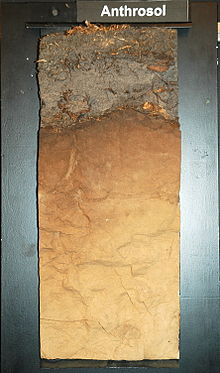Anthrosol
Anthrosol is a reference soil group of the World Reference Base for Soil Resources (WRB). All those soil types are summarized here that have long been used for arable or horticultural purposes and whose fertility has been increased by humans.
The soil improvement measures include z. B. the introduction of organic material, irrigation or special processing. In contrast to other soil types, the parent rock plays a very subordinate role in anthrosols.
Anthrosols and their distribution
Depending on the specific processing, a distinction is made between different types of anthrosols, which are defined by their respective diagnostic horizons:
- Anthrosol with Plagge horizon ( plaggic horizon ) on nutrient-poor, sandy soils often, especially in north-west Germany, Denmark, the Netherlands and Belgium. Plagues are the humus-rich topsoil, including parts of plants above and below ground, which was removed from certain areas and, mixed with excrement, ash and kitchen waste, applied to other areas. If this was repeated several times, powerful horizons of plague emerged.
- Anthrosol with irragric horizon in areas with intensive irrigation, such as Mesopotamia , India , China and often in oases . The irragric horizons are created by continuous deposits of sediment-rich irrigation water.
- Anthrosol with horizons created by wet rice cultivation , especially in China , South Asia and Southeast Asia . Plowing under water overflow creates an anthraquic horizon in which iron and manganese are reduced, which then accumulate in the subsoil ( hydragric horizon ) and develop pseudogley features.
- Anthrosol with a garden horizon ( hortic horizon ) with almost worldwide distribution, in areas with a longer settlement history. Characteristic are deep plowing and continuous fertilization with waste and other organic substances from the settlement area (kitchen waste, compost or liquid manure).
- Anthrosol with field / garden horizon ( terric horizon ) in areas of intensive and long-lasting soil improvement by adding minerals such as lime (lime melioration , especially England ), mineral-containing sludge and coastal sands . They are characterized by strong biological activity, are neutral to slightly alkaline (pH value of the soil water normally> 7) and often contain free carbonate . Characteristic are the elevation of the floor resulting from the prolonged addition of material and a noticeable proportion of small artifacts such as bricks or ceramics.
- Anthrosol with a charcoal horizon ( pretic horizon ). Such soils are particularly found in the Amazon region. They were created before these areas were conquered by European colonial powers. However, its further interpretation is controversial. The charcoal increases the cation exchange capacity . In addition, nutrients were brought in with the help of ashes, excrement and kitchen waste (hunting, fishing, harvesting).
Local names
Local names for special anthrosols are, for example, Terra Preta de Indio for a Pretic Anthrosol , which is mainly found in the Amazon basin of Brazil. Paddy Soil is the English name for Hydragric Anthrosol . This is an "anthropogenic pseudogley " created under wet rice cultivation .
Web links
- Profile photos (with classification) WRB homepage
- Profile photos (with classification) IUSS World of Soils
literature
- IUSS Working Group WRB: World Reference Base for Soil Resources 2014, Update 2015. World Soil Resources Reports 106, FAO, Rome 2015. ISBN 978-92-5-108369-7 ( PDF 2.3 MB).
- W. Zech, P. Schad, G. Hintermaier-Erhard: Soils of the world. 2nd Edition. Springer Spectrum, Heidelberg 2014. ISBN 978-3-642-36574-4 .
- W. Amelung, H.-P. Blume , H. Fleige, R. Horn, E. Kandeler , I. Kögel-Knabner , R. Kretschmar, K. Stahr , B.-M. Wilke: Scheffer / Schachtschabel textbook of soil science. 17th edition. Heidelberg 2018. ISBN 978-3-662-55870-6 .

